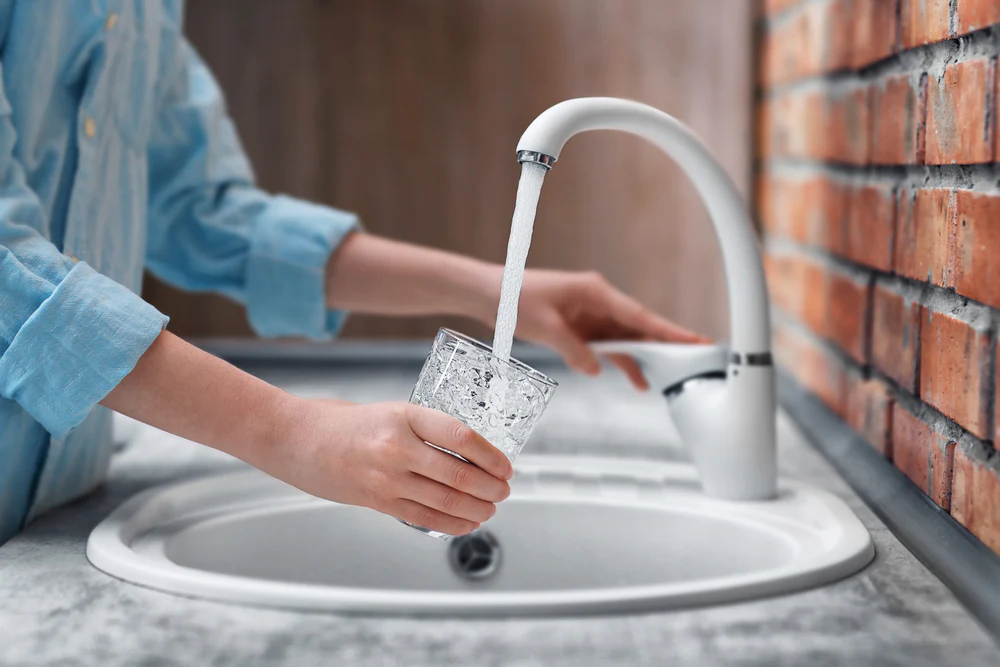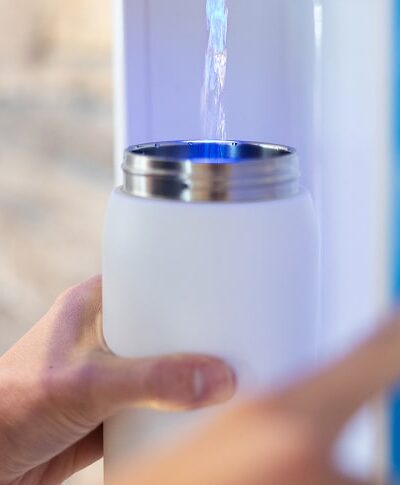Updated July 7 2024
There are several factors that determine water quality. The originating source, mineral and chemical content, and whether the water is hard or soft. The United States Geological Survey defines water hardness as the “amount of dissolved calcium and magnesium in water.”
So, is hard water safe to drink? Generally speaking, hard and soft water are both considered safe to drink.
However, there is increasing evidence that shows the effects of drinking hard water, both good and bad. Collective investigations conducted by researchers in India present evidence that the hardness of drinking water may reduce adverse health effects, such as cardiovascular disease and certain cancers, among other serious health conditions and diseases.2 Studies suggest there may also be correlation between a high level of magnesium in hard water with some anti-stress activity against coronary heart disease.
Alternatively, the same collection of research points to the effect of water hardness in reproductive health, particularly in men. Some reports show the occurrence of reproductive failure due to excess calcium in hard water, as well as a negative influence on fertility. The reports referenced focus on oxidative stress as inducing infertility in men by calcium, although there were also beneficial effects of magnesium.
When considering the question of is hard water safe to drink, one key factor to keep in mind is the varying levels of mineral ions in the water itself. Water hardness level is based on concentrated calcium carbonate levels. Levels of anything more than 300 milligrams per liter (mg/L) is considered very hard water, while anything below 75 mg/L is considered soft water.
In between, there is a range of water hardness categorized by how much calcium is detected in the supply. Since drinking hard water isn’t considered a health concern, there’s not necessarily an ideal water hardness. However it can be damaging in other ways.
How to Determine If Your Home Has Hard Water
Hard water is easy to identify due to the visible signs it leaves behind. Signs of hard water include remaining spots, stains, and a soapy film after washing clothes, doing the dishes, taking a shower, or washing your hands.4
- Spots and stains. Hard water leaves calcium carbonate deposits behind which are visible on the dishes and clothing. This can lead to scale buildup if left alone. Also, too much calcium in the water can be harsh on fabrics and cause clothes, towels, and bedding to wear out faster.
- Soap scum. A lingering residue on your hands after washing your hands is an indicator of hard water. The calcium content in the water reacts with the soap to create soap scum. As a result, you may have to rinse your hands for longer if you want suds to be rinsed cleanly away.
- Poor water pressure. The more mineral build up there is, the more room it takes up in the pipes, reducing the water flow and resulting in poor pressure. It can make it more difficult or take longer to bathe properly due to the lack of pressure coming from the faucet.
The opposite of these characteristics are true when dealing with soft water. However, water with higher levels of sodium ion often can leave behind a distinctive taste. There’s a higher risk for people with high blood pressure when there’s a higher sodium content in the water.3 Additionally, soft water may also pick up lead and other chemicals that leach from old water pipes and end up in your tap water, which is harmful to one’s health.
If you’re noticing that your water smells bad, we cover potential sources and alternatives available for clean drinking water.
Testing for Hard Water in the Home
In addition to looking for visible signs of hard water, you can also request a commercial or residential water quality report from your public water service. Every municipality is required to provide an annual report to residents each year, which shares the different levels of minerals, contaminants, and pollutants found in the city’s water supply.
Often referred to as the Consumer Confidence Report or CCR, the information includes how much calcium, magnesium, and sodium is found in the water, the mineral that determines water hardness or softness. Water hardness is often calculated as grains of hardness per gallon of water or milligrams of hardness per liter of water.5 The categorized amounts as classified by the U.S. Department of Interior and Water Quality Association are as follows:
- Soft water = 0-1 grains/gallon or 0-17.1 mg/l or ppm
- Slightly hard water = 1-3.5 grains/gal or 17.1-60 mg/l or ppm
- Moderately hard water = 3.5-7.0 grains/gal or 60-120 mg/l or ppm
- Hard water = 7.0-10.5 grains/gal or mg/l or ppm
- Very hard water = 10.5 and over grains/gal or 180 and over mg/l or ppm
As the numbers show, there is quite a bit of variation that indicates the spectrum of soft water to very hard water, which affects its quality. Although your CCR may list the types and amounts of minerals in your water, these can fluctuate from year to year and municipalities are not required to manage the hardness level of the water provided.
Finding what would be considered an ideal water hardness is finding a balance of keeping what’s beneficial in original water supplies while eliminating the bad.
Ensuring Safe Drinking Water with At-Home Filtration
Hard water may not be explicitly harmful to your health, but it isn’t necessarily beneficial either. Hard water is caused by groundwater areas with a high mineral content, which may also be the breeding ground for other run-off as well.
Tap water that originates from water sources near industrial plants, farms, or highly populated cities often contains a greater number of chemicals and pollutants due to what is washed away and infiltrating the ground. You may use a water softener system but this does not guarantee that the softened water is safe for human consumption.
So, can you drink sink water? To ensure the safest possible drinking water solution, it’s best to use at-home filtration to regulate what you’re drinking. The Centers for Disease Control and Prevention provides a guide to different water treatment technologies to use in the home.6 The main methods include filtration, reverse osmosis, and distillation.
Filtration
Filtration occurs when liquids, gasses, and dissolved minerals or suspended matters adhere to the surface of an absorbent medium. The success of filtration depends on the amount and size of the contaminant particles. There are three subcategories: microfiltration, ultrafiltration, and nanofiltration.
- Microfiltration has a pore size equal to approximately 0.1 micron and is most effective in removing protozoa. It’s also moderately effective in removing bacteria, like salmonella or E.coli, but not effective in removing viruses or chemicals.
- Ultrafiltration has a pore size equal to approximately 0.01 and is highly effective in removing protozoa and bacteria, moderately effective in removing viruses, and low effectiveness in removing chemicals.
- Finally, nanofiltration, the smallest at 0.001 micron is highly effective at removing protozoa, bacteria, and viruses, with a moderate effectiveness in removing chemicals.
Due to these differences, not all water treatment systems purify water in the same way. With water filter pitchers, for example, they may capture most but not all contaminants found in tap water. Additionally, these filters must be changed regularly in order to maintain a consistently high filtration rate.
Reverse Osmosis
Another popular water treatment method is reverse osmosis. Reverse osmosis reverses the flow of water in a natural process of osmosis so water passes from a more concentrated solution to a more diluted solution through a semipermeable membrane.
This level of filtration system has a pore size of 0.0001 micron and is highly effective in removing the same level of pollutants as nanofiltration, in addition to removing common chemical contaminants, such as copper, chromium, lead, and sodium. It may also be helpful in reducing chemicals such as arsenic, radium, calcium, magnesium, among others.
Distillation
Distillation is a water filtration process that heats water to a boiling point, and then collects the condensed water vapor, thereby leaving contaminants behind. It has a similar effective rate for purification as reverse osmosis, although this process is more time-consuming and mostly performed on small batches of water at a time.
Advanced Water Purification with FloWater
Fortunately, with FloWater, there are several steps of purification and filtration to get the cleanest, best-tasting water possible. There is a sediment filtration, in addition to an advanced osmosis level, as well as several other stages to purify and improve the taste of tap water. It takes the water filtration technologies most commonly used and combines them into one system.
With the FloWater Refill Station, tap water is transformed as it goes through individual filters and purification that catch all types and sizes of contaminants, including bacteria, viruses, chemicals, and other pollutants that get into the water. It also improves the quality of water by adding back beneficial minerals and electrolytes in trace amounts.
The FloWater Faucet Filter uses a five-stage micron carbon block filter to reduce lead, mercury, arsenic to undetectable levels and reduce fluoride to a safe parts per million concentration. With both types of at-home water technologies easily accessible, it allows people to use their originating water source to create fully purified, clean, safe drinking water.
Sources:
- “Hardness of Water.” The United States Geological Survey. https://www.usgs.gov/special-topic/water-science-school/science/hardness-water?qt-science_center_objects=0#qt-science_center_objects
- Sengupta, Pallay. Department of Physiology, Vidyasagar College for Women, University of Calcutta, Kolkata, West Bengal, India. Potential Health Impacts of Water. International Journal of Preventive Medicine. https://www.ncbi.nlm.nih.gov/pmc/articles/PMC3775162/
- “Hard Water vs. Soft Water: Which One Is Healthier?” Healthline.com. https://www.healthline.com/health/hard-water-and-soft-water#Whats-the-difference-between-hard-water-and-soft-water?
- “Drinking Water: Hard Water.” Cambridge Water Department. https://www2.cambridgema.gov/CityOfCambridge_Content/documents/Drinking%20WaterMy%20edition.pdf
- “A Guide to Drinking Water Treatment Technologies for Household Use.” Centers for Disease Control and Prevention. https://www.cdc.gov/healthywater/drinking/home-water-treatment/household_water_treatment.html




